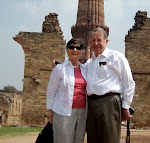








Most of us probably don't spend a lot of time on where the waste from our home goes--I know that has not been high on my list of things to dwell on. Here in India, however, that has been a continuing topic of thought, discussion, and finally action! When we were home at Christmas, Ron casually mentioned to our son-in-law, Bob Tempest, that if he wasn't super busy with his underground pipe construction work in Salt Lake, he might consider coming to India and helping Ron watch the construction on the new buildings begin--kind of be a supervisor of sorts. Bob agreed; it was a good time for him to leave for a few weeks and he thought that would be an interesting thing for him to do. As the days moved toward the beginning of March when Bob was planning to come, Ron realized that with our supervisor that we had engaged to watch the materials, building processes, how the decisions were made by the contractor, that Bob would not have a needful job in that area. HOWEVER, how would Bob feel about building us a septic system that would take care of all the waste from all the buildings (old and new) so that it never ran down our pathways in open ditches again!?! (Also, so we would never smell it again.)
Hmm... Bob had never built a septic system before but he would get some books and study up on it before he got there. Sounded like a good project to him.
Sunday, March 29, Bob left Chennai on the train to Agra with his sister Lynne. Lynne had come to spend a few days at Rising Star with us, and then would travel with Bob to Agra (Taj Mahal), the New Delhi area then on to Tokyo for a few days before returning home. What he left behind at Rising Star Outreach was possibly the finest septic system in all of India. He had accomplished the miraculous: In three weeks time he had designed, mobilized an Indian labor force (none of whom spoke English except for the supervisor Victor, who spoke limited English), and completed a magnificent system that will serve us for years to come. We're all still scratching our heads as to how he did this. We did feed him a lot of good Indian food, so that probably helped his efforts.
I'm going to give you the shortened version of the process, but if you're bored by septic system design, you can sign off now. The RESEARCH began in the US for Bob--we had also been working with a Sanitation Engineer here by the name of Balusundaram. Ron picked Bob up at the airport and went straight to his office. They conferred, but Ron and Bob decided to modify the design Balusundaram had drawn and go with a system that is familiar to the U.S.
The system used includes a septic tank to hold solid wastes plus perforated pipe laid in gravel filled trenches for the effluent. The bacteria disposes of solids, although periodic pumping is usually required. The effluent is filtered through gravel and soil to become clean.
The DESIGN included the Field: 10 trenches, 3 feet wide, 5 feet deep, 100 feet long. Gravel 3 feet deep would fill each of those 10 trenches, plus one trench that bisected and connected all of them down the center from the main connections. Pipe: 4 inch perforated every 6 inches, all laid perfectly level. (Perforation was down with a power drill on site.) Cover: Coconut leaves from the property laid on the pipe (no soil fabric in India). Soil Cover: 2 feet.
They then connected to existing school and hostel drain lines, approximately 350 feet, and designed how the connection to the new school wing would be added on as well as the new volunteer hostel and dining/kitchen block when we are ready to connect.
Manholes (4 or them) were constructed to intercept and direct the effluent. They also provide access to pipe for clean out or repair. Bob was continually working his calculations for the necessary size, elevations and required slope to insure drainage.
CONSTRUCTION-- a Backhoe (JCB as it is known here) dug all the trenches, placed gravel and back filled completed work. Survey Instruments (which included mainly a string line and a survey tool--we had no levels), determined elevations to insure proper gradients for drainage and disposal. Bob supervised All work: directed the backhoe in the trenches, walking in front of it, calculated and verified proper grades, prepared the budget, and did hand labor himself as needed. His Labor Force included 4 brick masons to build manholes, 3 men to spread and level gravel, 3 men to drill the perforations in the pipe and connect and lay the pipe, and cover with coconut leaves. 8 women to carry material and other work as required. Our supervisor Victor arranged and supervised labor, along with Bob.
MATERIALS--?? tons of gravel (a lot!), 4" pipe (we perforated), 6" connecting pipe, glue, brick, mortar, concrete manhole lids (fabricated on site), coconut leaves (from property.) Tractor and trailer moved dirt and gravel.
TIME: Friday night was the final hookup with the hostels (done late with flashlights when drainage was low.) Saturday morning we had a celebration with a banner, children singing, and a couple of short speeches. There was the symbolic shovel of dirt into the smelly ditch to complete the ceremony. It had been 18 days!!! A miracle? YES, but as with most miracles God often uses individuals to make things happen--Bob brought us a miracle. Thank you Bob Uncle for sweet, healthy, clean air!





















